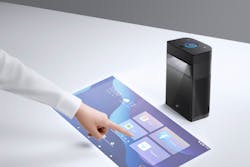When you are walking around a trade show with six different and diverse expo floors, it is downright impossible to see everything, and for the stuff you actually see, it is extremely difficult to really get your arms around it and actually draw a direct link to the industry relevant to you.
Such is the challenge of walking around at CES – something I was privileged to do for just the second time in my life this January. Yes, the idea of one man covering six show floors in the span of about 36 hours is as laughable as I write this as it was when I first set foot in the familiar Sands Convention Center. But I was determined to do my publisher, myself and all of you proud, so I took a selfie in front of the smart home section and went to work.
The smart home section turned out to be the easy part. In the smart home area, there is a clear delineation between security-related (the smart locks and the video cameras and the alarm systems) and not related (the smart toothbrushes and the smart TOILETS to name a couple).
I remember talking to Axis Communications guru Fredrik Nilsson many years ago about how we can almost draw a direct line from innovations in consumer electronics to cutting-edge breakthroughs in the security industry. 4K video is certainly an easy one to think of. But when you are on that floor and venture away from that smart home section, that line from those trends to our industry that Fredrik told me about seemed about as straight as a 90-degree angle.
So…it was time to think out of the box. Here are a handful of innovations that, if you can make the leap to our industry, might be coming to a security manufacturer near you (in a few years, maybe more):
Remote truck rolls: Here’s a potential game-changer for integrators – TeamViewer Pilot uses augmented reality (AR) for remote support. Using a computer, tablet or smartphone, users can enable a troubleshooter to access devices within a home or business. Via a remote session, the troubleshooter can see issues on a device and visually help the user fix tech problems with 3D markers, freehand drawings, and text annotations to highlight specific details.
Virtual alarm keypads: Hachi Infinite is a smart home projector that turns any flat surface into an interactive touchscreen. If your customer thinks that wall-mounted keypad is ugly and they don’t want to be glued to their phone, this may be just the solution.
Ultrasonic detection: Elliptic Labs’ AI Virtual Smart Sensor Platform creates virtual sensors by using any device’s microphone and speaker. Inaudible ultrasonic tones can be interpreted to detect presence or gestures, respectively. Arm your panel with a wave of the hand? Perhaps!
The AI nose knows: Stratuscent’s electronic nose (eNose) leverages chemical sensors and AI for detection, identification, and analysis of complex scents. Found in the startup section of the show (Eureka Park), it is a portable device that detects both simple chemicals and complex everyday scents. Not hard to see this as a portable explosives detection alternative, or perhaps as a new smoke detection method.
Of course, there was so much more to be seen and inferred...but I bet most of it will be seen and applied in the years to come.
Paul Rothman is Editor-in-Chief of Security Business magazine (www.securitybusinessmag.com). Email him your comments or topic suggestions at [email protected].



